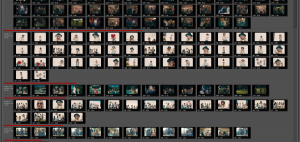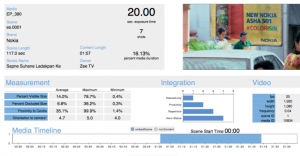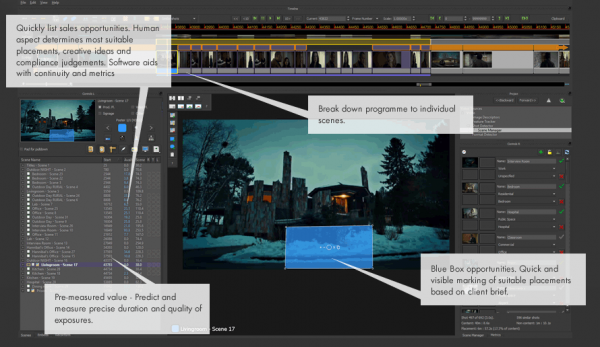Product placement is nothing new, nor is the idea that it is the solution to the TiVo problem. More than mere Coke billboards in the background, we’ve seen increasing blatant brand-integration in TV shows, movies, and, especially, music videos for over a decade. It’s been a great solution for all those terrified advertisers out there worried we’d never watch a traditional advertisement again. And now, as evidence by advertising from Mirriad, it’s become stunningly automated, and is branded specifically as “advertising for the skip generation.”
Considering I spend at least 30 minutes of each day hovering a finger or cursor over “skip” buttons and little Xs, waiting for them to turn opaque, I suppose that’s fair.
 In any event, much of this brand integration has become something that happens in post. I’m not sure if you’ve seen a TV vfx reel lately, but there’s a whole lot of enhancement and reconstruction going on out there, and VFX artists have gotten very very, super good at compositing well enough to not be noticed by the causal viewer. Enter Mirriad, a company that uses those techniques to take product placement to a whole new level. To put it simply, Mirriad is a platform that allows content creators to have their work “scanned” for ad opportunities. They promote ideas like “flexible targeting,” “guaranteed exposure,” and “measurable impact” to brands while offering to “monetize existing content,” “re-use inventory,” and “generate unlimited revenue” for content owners.
In any event, much of this brand integration has become something that happens in post. I’m not sure if you’ve seen a TV vfx reel lately, but there’s a whole lot of enhancement and reconstruction going on out there, and VFX artists have gotten very very, super good at compositing well enough to not be noticed by the causal viewer. Enter Mirriad, a company that uses those techniques to take product placement to a whole new level. To put it simply, Mirriad is a platform that allows content creators to have their work “scanned” for ad opportunities. They promote ideas like “flexible targeting,” “guaranteed exposure,” and “measurable impact” to brands while offering to “monetize existing content,” “re-use inventory,” and “generate unlimited revenue” for content owners.
In effect, Mirriad will scan your TV episode and find any blank walls, windows, or even cars and handheld props that can be swapped out with other images and 3D models. This is a largely computerized process, though how much of this is automated geometry detection and how much is a compositor watching and noting, “yeah, I can turn that Honda into an Audi” is not 100% clear to me, but they say it’s a fast process. You can see a breakdown of all the different ways the computers are scanning the images on this page (it’s pretty cool stuff, frankly). Here it is in action:
Next you’re looped into an interface that effectively lists ads and rates you can get for your digital space- i.e. that blank wall will net you $1,000 to paste in an Arby’s ad, or you can get $700 from  Beats (or whatever- those numbers are made up). They keep track of metrics, the whole deal. The way a website can use Google Analytics to keep track of acute visitor information, it appears content creators can similarly keep track of discrete ad impression data on their content, making the whole system smarter. It also suggests the possibilities of dynamic product placement – if you fire up Hulu to watch Agents Of S.H.I.E.L.D. here in Georgia, Agent Coulson will of course be drinking a Coke that is then magically a Pepsi if you’re watching in Arizona (or wherever they drink that shit).
Beats (or whatever- those numbers are made up). They keep track of metrics, the whole deal. The way a website can use Google Analytics to keep track of acute visitor information, it appears content creators can similarly keep track of discrete ad impression data on their content, making the whole system smarter. It also suggests the possibilities of dynamic product placement – if you fire up Hulu to watch Agents Of S.H.I.E.L.D. here in Georgia, Agent Coulson will of course be drinking a Coke that is then magically a Pepsi if you’re watching in Arizona (or wherever they drink that shit).
I don’t mean to advertise for the advertisers here, but to me it’s fascinating just how slick and automated this process has become. It also raises the question- does this make these budget-enhancing avenues available to smaller productions and filmmakers that could do great things  with every extra buck? Is it so terrible to put ads in your frame in places where there would probably be ads in the real world? And as this progresses, is my particularly popular Vine of my buddy leaping off the side of a building into a dumpster full of Burrito Salads going to be a candidate for having Taco Bell plaster their logo on the wall? As we all fall together with auto-company logos whizzing by, how far does this rabbit hole go?
with every extra buck? Is it so terrible to put ads in your frame in places where there would probably be ads in the real world? And as this progresses, is my particularly popular Vine of my buddy leaping off the side of a building into a dumpster full of Burrito Salads going to be a candidate for having Taco Bell plaster their logo on the wall? As we all fall together with auto-company logos whizzing by, how far does this rabbit hole go?
Interestingly, any naive utopian fantasy of a world without (or even fewer) ads fizzled long ago, as you can’t even chug down a 30 second video of a cat falling off a table without being blasted with the first 15 seconds of a beer ad. While Netflix remains a largely ad-less experience, Youtube, Hulu, and virtually every other disruptive media delivery platform has long since linked ads and content inextricably. In other words, traditional ads are as unskippable as ever and have nearly endless content through which to target consumers. That hasn’t stopped some very smart people from coming up with new, very sophisticated ways to get brands in front of your eyeballs.
Thanks for reading.

